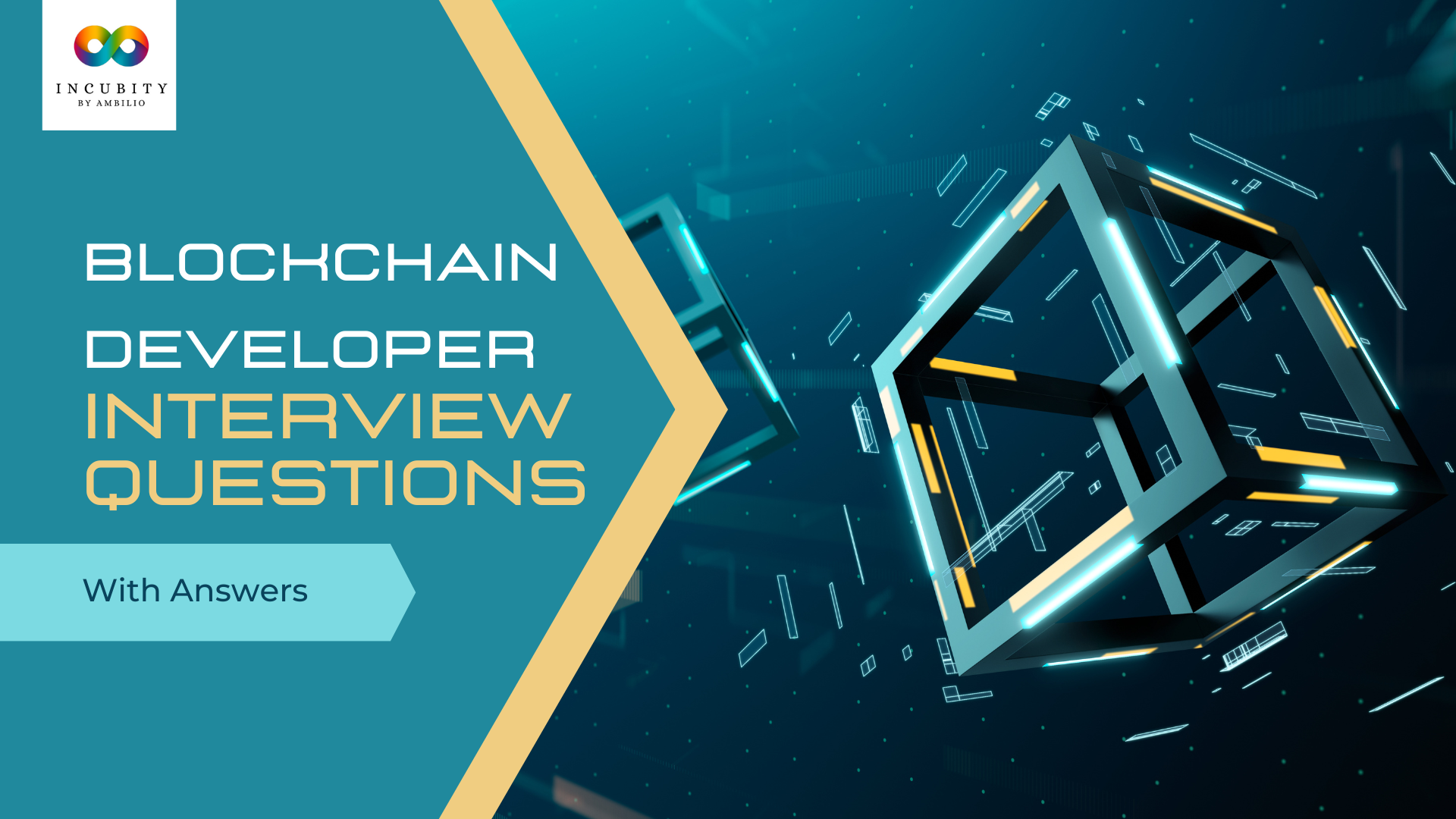Here is the list of top questions asked in blockchain developer interviews with their possible answers. These Blockchain Developer interview questions will help you get prepared for blockchain based job interviews.
Que: What is your experience with blockchain development?
Sample answer: “I have been working as a blockchain developer for two years now. During this time, I have developed several decentralized applications (DApps) using various blockchain platforms such as Ethereum, Hyperledger Fabric, and Corda. I have also worked on smart contract development and auditing, as well as token creation and integration.”
Que: What led you to pursue a career in blockchain development?
Sample answer: “I was drawn to blockchain development because of the technology’s potential to revolutionize various industries such as finance, healthcare, and supply chain management. I was particularly interested in the ability of blockchain to increase transparency, security, and efficiency in processes that are traditionally slow and inefficient.”
Que: How do you ensure the security of smart contracts?
Sample answer: “To ensure the security of smart contracts, I follow industry best practices such as code reviews, unit testing, and using automated tools to scan for vulnerabilities. I also implement a rigorous testing process to catch any issues before deployment.”
Que: How do you approach scaling a blockchain network?
Sample answer: “To scale a blockchain network, I would first analyze the current network and identify any bottlenecks or performance issues. Then, I would explore options such as sharding, sidechains, or layer-2 solutions like Plasma to increase scalability without compromising on security or decentralization.”
Que: What are the differences between public and private blockchains?
Sample answer: “Public blockchains like Bitcoin and Ethereum are open to anyone and have no central authority controlling them. Private blockchains, on the other hand, are restricted to a specific group of users and are often used in enterprise settings. Private blockchains can offer higher transaction speeds and more control over governance, but sacrifice some of the benefits of decentralization.”
Que: What programming languages are used in blockchain development?
Sample answer: “There are several programming languages used in blockchain development, but some of the most popular include Solidity for Ethereum, Go for Hyperledger Fabric, and Kotlin for Corda. It’s important to have a strong understanding of data structures and algorithms, as well as cryptography and distributed systems.”
Que: How do you handle interoperability between different blockchain platforms?
Sample answer: “Interoperability between blockchain platforms is a complex issue, but there are several approaches that can be taken. One option is to use cross-chain bridges that allow for the transfer of assets and data between different blockchains. Another option is to use protocols like Cosmos or Polkadot that aim to create a network of interoperable blockchains.”
Que: Can you explain the consensus mechanism used in your preferred blockchain platform?
Sample answer: “For example, in Ethereum, the consensus mechanism used is called Proof of Work (PoW). Miners compete to solve a cryptographic puzzle, and the first to solve it adds a block to the chain and receives a reward. In contrast, Hyperledger Fabric uses a different consensus mechanism called Practical Byzantine Fault Tolerance (PBFT), where participants in the network reach consensus through a voting process.”
Que: What is your experience with smart contract development?
Sample answer: “I have experience developing smart contracts in Solidity, the programming language used on the Ethereum platform. I have created smart contracts for various use cases such as voting, supply chain management, and asset tracking. I have also conducted code reviews and security audits of smart contracts to ensure they are secure and efficient.”
Que: How do you approach testing and debugging smart contracts?
Sample answer: “To test and debug smart contracts, I use various tools and methodologies such as unit testing, integration testing, and fuzz testing. I also use tools like Remix and Truffle to deploy and interact with contracts on a test network before deploying them to the main network.”
Que: What are some of the challenges facing the blockchain industry, and how would you address them?
Sample answer: “One of the main challenges facing the blockchain industry is scalability. To address this challenge, I would focus on exploring new solutions such as sharding and layer-2 solutions while maintaining a strong emphasis on security and decentralization.”
Que: What experience do you have with Solidity and smart contract development?
Sample answer: “I have extensive experience with Solidity and have developed several smart contracts for various use cases such as voting, supply chain management, and asset tracking. I am well-versed in the syntax and structure of Solidity and have a strong understanding of Ethereum’s Virtual Machine (EVM) and its inner workings.”
Que: What is your experience with blockchain protocols like Bitcoin, Ethereum, and Hyperledger Fabric?
Sample answer: “I have experience developing various blockchain protocols, including Bitcoin, Ethereum, and Hyperledger Fabric. I am familiar with the underlying mechanics of each protocol, such as their consensus mechanisms and data structures, and have a solid understanding of the development tools and languages used for each.”
Que: What is your experience with peer-to-peer networking protocols, such as TCP/IP or HTTP?
Sample answer: “I have extensive experience with various networking protocols, including TCP/IP and HTTP. I understand how these protocols work and how they are used to transmit data between nodes in a network. I also have experience implementing these protocols in blockchain networks to enable communication and data transfer.”
Que: How do you ensure data privacy and security in blockchain development?
Sample answer: “Data privacy and security are critical concerns in blockchain development. To ensure these concerns are addressed, I employ various security measures such as encryption, secure key storage, and access control. I also implement rigorous testing processes to identify and fix any vulnerabilities before deployment.”
Que: What do you think are the limitations of blockchain technology, and how would you address them?
Sample answer: “One limitation of blockchain technology is scalability. To address this issue, I would focus on exploring new solutions such as sharding, sidechains, or layer-2 solutions like Plasma. I would also prioritize optimizing transaction speeds and reducing network congestion without compromising on security or decentralization.”
Que: How do you manage consensus algorithms and proof-of-work versus proof-of-stake in a blockchain network?
Sample answer: “Managing consensus algorithms and proof-of-work versus proof-of-stake requires a deep understanding of how blockchain protocols work and how they are implemented. I have experience implementing both consensus algorithms and am familiar with the trade-offs between them in terms of security, speed, and energy consumption.”
Que: What kind of smart contracts have you developed before? Can you describe their functionality and the programming language you used?
Sample answer: “I have developed several smart contracts for various use cases such as voting, supply chain management, and asset tracking. For example, I developed a voting smart contract that allowed for secure and transparent voting using Ethereum’s Solidity language. The contract ensured one vote per person and prevented any tampering or manipulation of the results.”
Que: What is the role of nodes in a blockchain network?
Sample answer: “Nodes are computers that run the blockchain software and participate in the validation and processing of transactions. Each node maintains a copy of the blockchain and verifies new transactions before adding them to the blockchain. Nodes can be classified as full nodes or light nodes, depending on the amount of data they store and process.”
Que: How do you optimize the performance of a blockchain network?
Sample answer: “To optimize the performance of a blockchain network, I would focus on improving the speed and efficiency of transaction processing, reducing network congestion, and increasing the scalability of the network. This could be achieved through various methods such as implementing sharding, optimizing consensus algorithms, or using layer-2 solutions like Plasma or Lightning Network.”
Que: What is the difference between a hard fork and a soft fork?
Sample answer: “A hard fork is a permanent divergence in the blockchain, resulting in a split of the network. It occurs when the rules of the blockchain are changed in a way that is not backward compatible, meaning that nodes running the old software will not be able to validate transactions on the new chain. A soft fork, on the other hand, is a temporary divergence in the blockchain that is backward compatible, meaning that nodes running the old software can still validate transactions on the new chain.”
Que: Can you explain how a Merkle tree works?
Sample answer: “A Merkle tree is a tree data structure that is used to efficiently verify the integrity of large data sets. It works by recursively hashing pairs of data until only a single root hash remains, called the Merkle root. Each leaf node of the tree represents a single piece of data, and the intermediate nodes represent the hashes of their children. By comparing the root hash of a Merkle tree to a known trusted hash, the integrity of the entire data set can be verified efficiently.”
Que: Can you explain the concept of a double spend attack and how it can be prevented?
Sample answer: “A double spend attack is an attempt to spend the same digital currency twice, essentially creating new currency out of thin air. It can be prevented in a blockchain network by implementing a consensus mechanism that ensures that transactions are only added to the blockchain if they are valid and have not already been spent. This can be achieved through methods such as proof-of-work, proof-of-stake, or Byzantine fault tolerance.”
Que: Can you explain how smart contracts work in Ethereum?
Sample answer: “Smart contracts in Ethereum are self-executing programs that are stored on the blockchain. They contain the rules and regulations for an agreement between two parties, and automatically execute when the conditions of the contract are met. Smart contracts are written in a programming language called Solidity, and are executed on the Ethereum Virtual Machine (EVM). Once a smart contract is deployed to the blockchain, it cannot be modified or deleted.”
Que: Can you explain the difference between public and private keys in a blockchain network?
Sample answer: “Public and private keys are used to authenticate and encrypt transactions in a blockchain network. A public key is a unique identifier that is shared publicly and is used to receive transactions. A private key, on the other hand, is a secret key that is used to sign transactions and prove ownership of a particular public key. Private keys should be kept secure and should not be shared with anyone, as they can be used to access and spend the funds associated with the corresponding public key.”
Que: Can you explain the difference between proof of work (PoW) and proof of stake (PoS)?
Sample answer: “Proof of work and proof of stake are two consensus mechanisms used in blockchain networks. PoW involves solving complex mathematical problems to validate transactions and create new blocks on the chain, while PoS involves staking a certain amount of cryptocurrency to validate transactions and create new blocks. PoW is more energy-intensive, while PoS is more cost-effective and environmentally friendly.”
Que: How does a Merkle tree work in a blockchain network?
Sample answer: “A Merkle tree is a data structure used to efficiently verify the integrity of transactions in a blockchain network. It is constructed by hashing pairs of transactions until a single root hash is produced, which can be used to verify that a particular transaction is included in the block. This helps to prevent tampering with the data on the blockchain.”
Que: What is a zero-knowledge proof and how is it used in a blockchain network?
Sample answer: “A zero-knowledge proof is a cryptographic method used to verify that a particular piece of information is true without revealing any additional information. It is used in blockchain networks to improve privacy and security by allowing users to prove ownership of a particular piece of information without revealing that information to others.”
Que: How does a blockchain network prevent double-spending?
Sample answer: “Double-spending is a common problem in digital currencies where the same funds are spent multiple times. In a blockchain network, this is prevented by using a consensus mechanism to verify transactions and adding them to the immutable ledger. Once a transaction is confirmed and added to the blockchain, it cannot be modified or deleted, preventing the same funds from being spent again.”
Que: Can you explain the difference between a smart contract and a traditional contract?
Sample answer: “A smart contract is a self-executing contract with the terms of the agreement between buyer and seller being directly written into lines of code. The code and the agreements contained therein exist on a blockchain network, and they execute automatically when predetermined conditions are met. Traditional contracts are written in natural language, and their execution is dependent on intermediaries such as lawyers, banks, or government institutions.”
Que: How does a blockchain network ensure transactional privacy?
Sample answer: “In a public blockchain network like Bitcoin, transactional privacy is ensured through the use of pseudonyms or public keys to maintain user anonymity. In a private blockchain network, privacy can be ensured through the use of encryption and access control mechanisms that restrict the visibility of the transaction details to a specific group of users.”
Que: What is the role of consensus algorithms in a blockchain network?
Sample answer: “Consensus algorithms are used to achieve agreement on the state of a blockchain network among multiple nodes. They ensure that all participants in the network have the same view of the transactions and their order. Consensus algorithms are essential to maintain the integrity and immutability of the blockchain network.”
Que: What is the role of miners in a proof-of-work blockchain network?
Sample answer: “In a proof-of-work blockchain network, miners use their computational power to solve complex mathematical problems and validate transactions. They are incentivized through the reward system to maintain the integrity of the network by following the protocol rules and validating transactions.“



